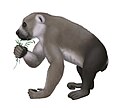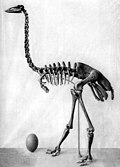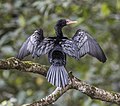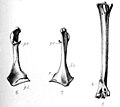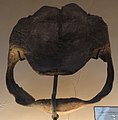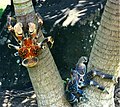

This is a list of Madagascar and Indian Ocean Island animals extinct in the Holocene that covers extinctions from the Holocene epoch, a geologic epoch that began about 11,650 years before present (about 9700 BCE) [lower-alpha 1] and continues to the present day. [1]
Contents
- Mammals (class Mammalia)
- Afrosoricidans (order Afrosoricida)
- Sea cows (order Sirenia)
- Rodents (order Rodentia)
- Primates (order Primates)
- Bats (order Chiroptera)
- Carnivorans (order Carnivora)
- Even-toed ungulates (order Artiodactyla)
- Birds (class Aves)
- Elephant birds (order Aepyornithiformes)
- Waterfowl (order Anseriformes)
- Flamingos (order Phoenicopteriformes)
- Grebes (order Podicipediformes)
- Cuckoos (order Cuculiformes)
- Pigeons and doves (order Columbiformes)
- Mesites (order Mesitornithiformes)
- Rails and cranes (order Gruiformes)
- Shorebirds (order Charadriiformes)
- Albatrosses and petrels (order Procellariiformes)
- Boobies, cormorants, and relatives (order Suliformes)
- Pelicans, herons, and ibises (order Pelecaniformes)
- Hawks and relatives (order Accipitriformes)
- Owls (order Strigiformes)
- Kingfishers and relatives (order Coraciiformes)
- Falcons (order Falconiformes)
- Parrots (order Psittaciformes)
- Passerines (order Passeriformes)
- Reptiles (class Reptilia)
- Crocodilians (order Crocodilia)
- Squamates (order Squamata)
- Turtles and tortoises (order Testudines)
- Ray-finned fish (class Actinopterygii)
- Cichlids and convict blennies (order Cichliformes)
- Toothcarps (order Cyprinodontiformes)
- Insects (class Insecta)
- Butterflies and moths (order Lepidoptera)
- Copepods (class Copepoda)[lower-alpha 3]
- Order Calanoida
- Order Cyclopoida
- Malacostracans (class Malacostraca)
- Order Decapoda
- Snails and slugs (class Gastropoda)
- Order Stylommatophora
- Order Littorinimorpha
- Bivalves (class Bivalvia)
- Order Unionida
- See also
- Notes
- References
The Republic of Madagascar is a large island country in the Indian Ocean, off the coast of East Africa. Other Indian Ocean islands near Madagascar include the Mascarene Islands (split between the Republic of Mauritius and the French department of Réunion), the Republic of Seychelles, and the Comoro Islands (split between the Union of Comoros and the French department of Mayotte).
Madagascar and the Indian Ocean islands are a biodiversity hotspot. The wildlife of Madagascar evolved in isolation and is distinct from the wildlife of Africa and other continents. Approximately 90 percent of all plant and animal species found in Madagascar are endemic. [2] Lemurs are endemic to the island of Madagascar.
Numerous animal species have disappeared from Madagascar and the Indian Ocean islands as part of the ongoing Holocene extinction, driven by human activity. The famous dodo (Raphus cucullatus), last seen in 1662, was endemic to Mauritius. [3] All 17 extinct lemurs were giant lemurs larger than the extant lemurs.
The subfossil remains of certain avian orders are scarce on Réunion. Consequently, a few of the extinct birds from Réunion are hypothetical species. They almost certainly existed but lack supporting subfossil remains. [4]
Locally extinct native species are included below, but human-introduced species that were later wiped out are not included.










